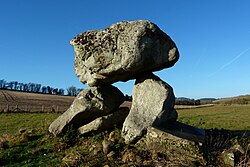| The Devil's Den | |
|---|---|
 | |
| Location | Fyfield, Wiltshire |
| Coordinates | 51°25′32″N1°46′58″W / 51.425678°N 1.782651°W |
| Architectural style(s) | British pre-Roman Architecture |
The Devil's Den shown within Wiltshire | |
The Devil's Den or Devil's Den is a dolmen burial chamber on Fyfield Hill near Marlborough, Wiltshire, England. The chamber is part of a Neolithic passage grave on Fyfield Down. Two standing stones, a capstone and two fallen stones are all that remain of what was the entrance to a long mound, described in the 1920s as being around 230 ft long (70 metres). [1] The capstone is believed to weigh 17 tons. [2] The burial chamber was reconstructed in 1921. [1] [3]

The dolmen was named after the devil, along with many other prehistoric remains, after the coming of Christianity. [4] A local tradition said that if water was poured into hollows on the capstone, a demon would come in the night and drink it. [2]
